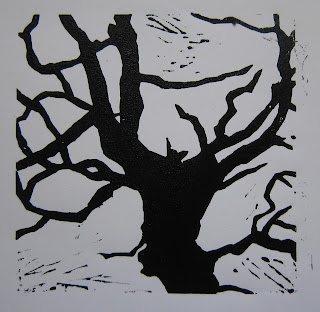I like the idea of an image superimposed on text. The text is printed in reverse. I do not know if this was accidental or on purpose but that is one of the reasons I find it fascinating. Maybe there is a secret message that is being hidden? It reminds me on one level of the writings of de Vinci. Also the colour choice here reminds me of doodles in blue biro. At first glance, a secret message written by hand?!
I think the graphic and simplistic nature of this image works very well for lino printing. Also the yellow on black contrasts well.
Great detail and intricate work done on this lino print. I love looking at the contrast between the black and white and the coloured version. I love the evident perspective in the black and white version but I think the colour choices are unexpected and work well. Its very interesting to see how colour can have such a huge influence on an image.
Another great example of how colour can influence images. However I think the actual lino cutting process is the most interesting aspect of these images. The lines in the cut pieces of the lino, especially in the green and black version have a lovely textural feel and for me, add a sense of an indistinguishable background. These marks have a rhythm which work with the stylised imagery.
An example of cardboard printing. A great alternative to printing in schools when there is no printing press or an interesting project to use recycled cardboard?!















































